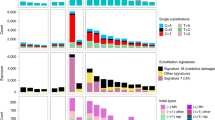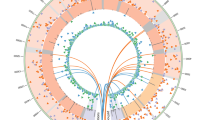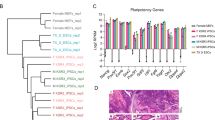Abstract
We compared bona fide human induced pluripotent stem cells (iPSCs) derived from umbilical cord blood (CB) cells and neonatal keratinocytes (K). As a consequence of both incomplete erasure of tissue-specific methylation and aberrant de novo methylation, CB-iPSCs and K-iPSCs were distinct in genome-wide DNA methylation profiles and differentiation potential. Extended passage of some iPSC clones in culture did not improve their epigenetic resemblance to embryonic stem cells, implying that some human iPSCs retain a residual 'epigenetic memory' of their tissue of origin.
This is a preview of subscription content, access via your institution
Access options
Subscribe to this journal
Receive 12 print issues and online access
$209.00 per year
only $17.42 per issue
Buy this article
- Purchase on Springer Link
- Instant access to full article PDF
Prices may be subject to local taxes which are calculated during checkout


Similar content being viewed by others
Accession codes
Change history
09 January 2012
In the version of this article initially published, the received date was incorrect. The correct received date is 17 February 2011. The error has been corrected in the HTML and PDF versions of the article.
References
Kim, K. et al. Nature 467, 285–290 (2010).
Polo, J.M. et al. Nat. Biotechnol. 28, 848–855 (2010).
Metallo, M.C., Ji, L., de Pablo, J.J. & Palecek, S.P. Methods Mol. Biol. 585, 83–92 (2010).
Irizarry, R.A. et al. Genome Res. 18, 780–790 (2008).
Doi, A. et al. Nat. Genet. 41, 1350–1353 (2009).
Bhattacharya, B. et al. BMC Dev. Biol. 5, 22 (2005).
Ball, M.P. et al. Nat. Biotechnol. 27, 361–368 (2009).
Soshnikova, N., Montavon, T., Leleu, M., Galjart, N. & Duboule, D. Dev. Cell 19, 819–830 (2010).
Stadtfeld, M. et al. Nature 465, 175–181 (2010).
Lister, R. et al. Nature 471, 68–73 (2011).
Bock, C. et al. Cell 144, 439–452 (2011).
Boulting, G.L. et al. Nat. Biotechnol. 29, 279–286 (2011).
Ohi, Y. et al. Nat. Cell Biol. 13, 541–549 (2011).
Acknowledgements
G.Q.D. was funded by US National Institutes of Health (NIH) grants DK70055 and DK59279, special funds received by the NIH under the American Recovery and Reinvestment Act (RC2-HL102815). K.K. was supported by NIH (K99HL093212-01), Leukemia and Lymphoma Society (3567-07), and Cooley′s Anemia Foundation. A.P.F. was funded by NIH grants R37CA054358 and P50HG003233.
Author information
Authors and Affiliations
Contributions
K.K., R.Z., K.N. and G.Q.D. conceived the experimental plan. K.K., R.Z., A.D., K.N., J.U., H.H., M.W.L., Y.-H.L. and H.L. performed the experiments. K.K., A.D., P.C. and M.J.A. performed data analysis. A.D., M.J.A. and A.P.F. performed CHARM and guided analysis of methylation. K.K., R.Z., A.D., K.N., J.U., P.C., J.J.C., M.W.L., A.P.F. and G.Q.D. wrote the manuscript.
Corresponding authors
Ethics declarations
Competing interests
G.Q.D. is a member of the scientific advisory boards of iPierian, Verastem, Epizyme, Solasia, MPM Capital and Johnson & Johnson.
Supplementary information
Supplementary Text and Figures
Supplementary Tables 1–6, Supplementary Methods and Supplementary Figures 1–15 (PDF 2438 kb)
Rights and permissions
About this article
Cite this article
Kim, K., Zhao, R., Doi, A. et al. Donor cell type can influence the epigenome and differentiation potential of human induced pluripotent stem cells. Nat Biotechnol 29, 1117–1119 (2011). https://doi.org/10.1038/nbt.2052
Received:
Accepted:
Published:
Issue Date:
DOI: https://doi.org/10.1038/nbt.2052
This article is cited by
-
Transcription factor-mediated direct cellular reprogramming yields cell-type specific DNA methylation signature
Scientific Reports (2023)
-
Gastruloids: A Novel System for Disease Modelling and Drug Testing
Stem Cell Reviews and Reports (2023)
-
Imprinting fidelity in mouse iPSCs depends on sex of donor cell and medium formulation
Nature Communications (2022)
-
Determining epigenetic memory in kidney proximal tubule cell derived induced pluripotent stem cells using a quadruple transgenic reprogrammable mouse
Scientific Reports (2022)
-
Modelling urea cycle disorders using iPSCs
npj Regenerative Medicine (2022)



